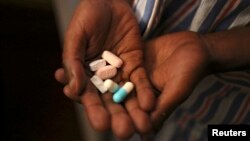The results of a new study published in the medical journal, The Lancet, asks how some of the 12 countries in sub-Saharan Africa will pay to expand efforts to fight the AIDS epidemic as international donor budgets tighten.
In South Africa, Botswana and Namibia, for example, AIDS funding comes primarily from domestic resources. But others such as Mozambique and Ethiopia depend heavily on foreign donors.
Many countries in Africa most affected by HIV are trying to expand their prevention and treatment activities, says one of the study’s authors, Dr. Robert Hecht, managing director of Results for Development Institute in Washington, D.C.
“This is going to cost more money over the next few years, but the question of where the funding will come from is complicated,” he said.
Focus on the most needy countries
He says the good news shows that the countries themselves can pick up a larger share of the cost of these expanded HIV programs. Donor agencies like the U.S. President’s Emergency Plans for AIDS Relief – called PEPFAR - and the Global Fund to Fight AIDS, Tuberculosis and Malaria can focus their remaining resources on the countries that most need their support.
“So this is a critical moment in the response to the AIDS epidemic,” said Hecht.
“We know that treatment programs are working," he continued. "We know that treatment also has a preventive effect; it slows down the rate of transmission of HIV. We have more tools on the prevention side like medical male circumcision. All of these things cost quite a bit of money, so the balance between the national -- the domestic funding -- and the outside funding needs to be re-thought, re-calibrated. And our study feeds right into that discussion and debate.”
The study found that even if countries such as Tanzania and Mozambique, for example -- where there is a high rate of HIV, and poor incomes -- were to put more resources into fighting HIV/AIDS, they would still need outside help.
“Even under the maximum, most optimistic scenario we would estimate that a country like Mozambique won’t be able to cover more than about 25 percent of the costs of its AIDS program. They’re going to need quite a bit of support for many years to come from PEPFAR and others,” said Hecht.
Stronger economies can pay their own way
One the other hand, he said their study found that countries such as South Africa and Namibia, while burdened with very serious AIDS epidemics, they have stronger economies, and will be able to fund their own AIDS activities without international support.
Hecht said a big challenge for the poorer economies countries is to enter into clearer and more specific agreements with PEPFAR and the Global Fund regarding their financial targets.
“So that over the next five years or seven years, all of the parties involved come to a clearer agreement -- strong agreement -- on how much money is actually needed and how much each of the different funding sources will pay,” he said.







